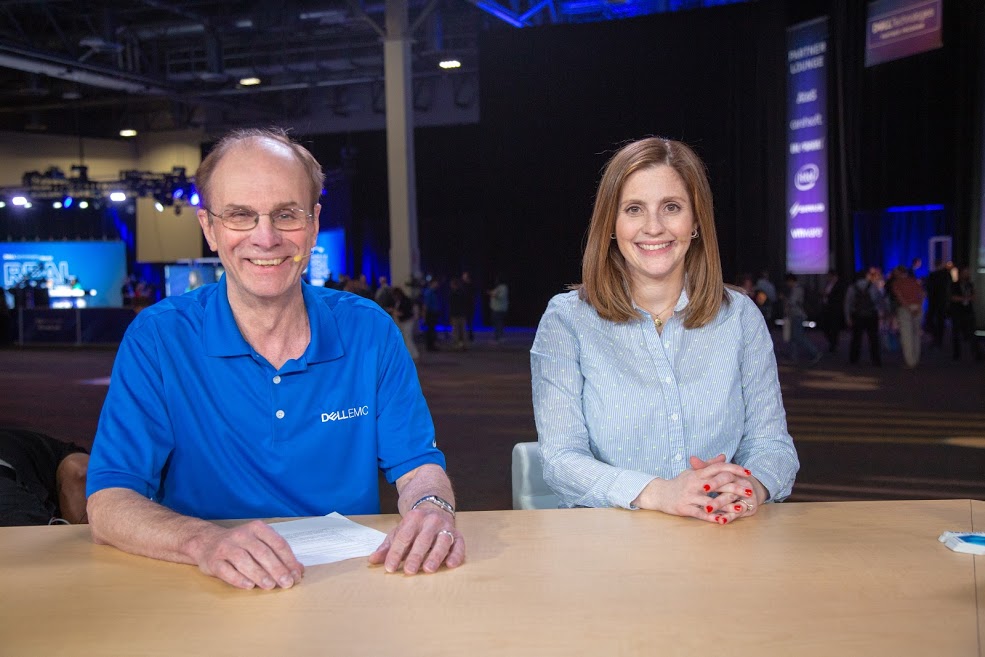 INFRA
INFRA
 INFRA
INFRA
 INFRA
INFRA
As the spirited discussion surrounding hybrid and multicloud data solutions continues to accelerate, storage and data protection remain top of mind. Dell Technologies Inc. is working with organizations to better understand their unique business demands, including storage, security and recovery strategies.
“The Dell Technologies Cloud is helping customers completely transform to a cloud operating model and [understand] the people, processes and technology implications of doing so,” said Alyson Langon (pictured, right), consultant of storage portfolio product marketing at Dell EMC.
Langon and Jay Krone (pictured, left), senior consultant of storage portfolio product marketing at Dell EMC, spoke with Rebecca Knight (@knightrm) and Stu Miniman (@stu), co-hosts of theCUBE, SiliconANGLE Media’s mobile livestreaming studio, during the Dell Technologies World event in Las Vegas. They discussed some of the biggest challenges businesses are facing, Dell’s work with VMware Inc., and how customers are reacting to some of the ongoing changes occurring in the cloud space (see the full interview with transcript here). (* Disclosure below.)
[Editor’s note: The following answers have been condensed for clarity.]
Miniman: Explain how cloud-enabled isn’t cloud watching — something like PowerMax.
Krone: PowerMax is just joining the Cloud family, and one of the things we have announced is an offering that we have through a cloud service provider that allows you, for example, as an existing PowerMax customer, to use [symmetrix remote data facility], to use native replication to replicate into the cloud, and then in a VMware environment. Here’s that disaster recovery use case coming: In a VMware environment, use Site Recovery Manager to perform a failover and then this service provider will spin up those VMs and VM works out on AWS. So what you get is an automatic failover for VMware environments with PowerMax.
Miniman: Bring us inside some of the conversations you’re having with customers. What are some of the top business challenges, and how are they different?
Krone: There’s the disaster recovery use case, which is new. The other thing that’s happening is there’s five years of learning that people have had around the public cloud. I was talking with a reseller, and one of the value propositions we have for this offering … is because the storage is at a service provider that is not the cloud provider. They can offer a different economic model. So people are finding new ways to go to the cloud for less money.
That works out well because it makes the cloud more affordable for everyone. It gives them and us some additional business opportunities, and, most importantly, it gives customers the ability to use the cloud consumption model, the [operating expense] model, and the outsourcing of the resources that they couldn’t do before. That’s the big thing. We’re basically enabling the public cloud in ways we couldn’t have done five years ago.
Knight: Where do you think the customers’ mindsets are right now? Are customers appropriately concerned about the threats they face and the requirements that are bearing down, or do they have their heads in the sand?
Krone: Everyone is concerned about security. We offer a model where your data is in the lockbox from Unity or Isilon or PowerMax, and it’s not in some amorphous place in the cloud. That gives people a lot of warm, fuzzy feelings. And things like data encryption still works on the storage arrays when it’s in the cloud.
Miniman: One of the things we’ve been talking about is the VMware and Dell EMC pieces that have come together more than ever. Many of the solutions, like VxRail, have [VMware Cloud Foundation] sitting on them. Can you talk about how the VMware and the Dell EMC storage pieces have been coming together even more?
Langon: The automated disaster recovery feature for our cloud storage services, that’s all about VMs, it’s all about VMware integration, and it really offers this disaster recovery as a service model for VMware environments who are running VMware Cloud on AWS. And they get that complete operational consistency.
That’s a huge benefit to our customers. So when you’re leveraging for the automated disaster recovery, it’s either PowerMax or Unity, including the new Unity XT, which was recently announced — being able to completely have operational consistency within your VMware environment from on-prem to the cloud.
In addition, VxRail is a key component of the Dell Tech Cloud. We also have our key storage platforms, which are validated with the VMware Cloud Foundation for some more high-performance workloads. So we have things like PowerMax and Unity that are also validated with VMware Cloud Foundation to get that best-of-breed storage as part of that stack.
Watch the complete video interview below and be sure to check out more of SiliconANGLE’s and theCUBE’s coverage of the Dell Technologies World 2019 event. (* Disclosure: Dell Technologies Inc. sponsored this segment of theCUBE. Neither Dell nor other sponsors have editorial control over content on theCUBE or SiliconANGLE.)
THANK YOU